The three phase inverter market is estimated to be valued at USD 3.1 billion in 2025 and is projected to reach USD 6.2 billion by 2035, registering a compound annual growth rate (CAGR) of 7.3% over the forecast period.
The three phase inverter market is projected to grow from USD 3.1 billion in 2025 to USD 4.4 billion by 2030, marking the first five-year growth block of the broader forecast towards USD 6.2 billion in 2035 at a CAGR of 7.3%. Year-on-year values move from 3.1 billion in 2025 to 3.8 billion in 2028, reflecting steady adoption driven by increasing demand for energy-efficient solutions in industrial, commercial, and renewable applications. The steady climb in this block indicates consistent investment in grid integration, backup power systems, and solar PV, positioning the market as a reliable and necessary component in modern power systems.
By 2030, the market is expected to reach 4.4 billion, showing a compounded increase throughout the block. Growth is supported by the push for robust power conversion in renewable energy integration, as well as the demand from sectors requiring uninterrupted, stable power supply. In my view, this growth block demonstrates the growing role of three-phase inverters in energy transition strategies, offering a stable opportunity for suppliers. Suppliers focusing on scalability, cost-effectiveness, and service networks are expected to benefit from the market’s continued steady expansion. The trajectory suggests long-term value, with the inverter market becoming an integral part of energy management systems across multiple industries.
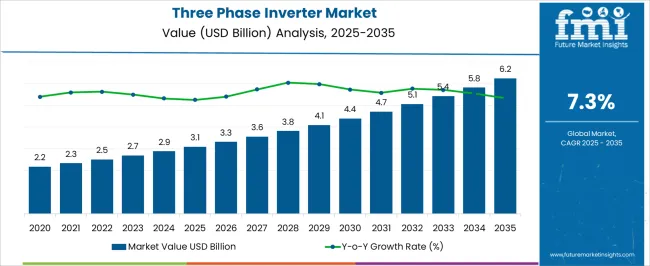
| Metric | Value |
|---|---|
| Three Phase Inverter Market Estimated Value in (2025 E) | USD 3.1 billion |
| Three Phase Inverter Market Forecast Value in (2035 F) | USD 6.2 billion |
| Forecast CAGR (2025 to 2035) | 7.3% |
The three phase inverter market holds a significant position within several larger sectors, primarily contributing to the power electronics and solar inverter markets. Within the power electronics market, it accounts for approximately 10-12%, driven by the growing adoption of efficient power management systems. In the solar inverter market, its share is notably higher, around 20-25%, as three phase inverters are essential in large-scale solar power generation systems. The renewable energy market reflects a contribution of about 15-18%, as three phase inverters are critical for the efficient conversion of energy in renewable power plants, such as solar and wind farms. In the industrial power systems market, the three phase inverter market holds approximately 8-10%, as these devices are crucial for various industrial applications, including motor drives and automation systems.
Finally, within the electrical equipment market, it represents a smaller share of about 5-7%, as the broader market encompasses a wide range of products, from circuit breakers to transformers. The increasing demand for clean energy solutions and efficient energy conversion drives the growth of the three phase inverter market, making it an integral part of these parent sectors. These percentages illustrate the expanding role of three phase inverters across industries as they enable more reliable, cost-effective energy solutions.
The three phase inverter market is experiencing consistent growth driven by the rising adoption of renewable energy systems, advancements in power electronics, and the expansion of distributed energy resources. Increasing installations of solar photovoltaic systems and wind energy solutions are creating sustained demand for efficient and reliable inverter technologies.
Enhanced grid integration requirements and regulatory mandates for energy efficiency are further accelerating deployment. Technological innovations such as higher power conversion efficiency, improved thermal management, and integrated smart monitoring capabilities are expanding the application range across residential, commercial, and industrial sectors.
With global focus shifting toward sustainable energy transitions, the market outlook remains positive, offering opportunities in grid tied systems, backup power solutions, and smart energy management platforms.
The three phase inverter market is segmented by type, power rating, end-use industry, and geographic regions. By type, three phase inverter market is divided into voltage source inverter (VSI), current source inverter (CSI), hybrid inverter, and others. In terms of power rating, three phase inverter market is classified into low power (Up to 10 kW), medium power (10 kW to 500 kW), and high power (Above 500 kW). Based on end-use industry, three phase inverter market is segmented into residential, commercial & industrial, renewable energy, and others. Regionally, the three phase inverter industry is classified into North America, Latin America, Western Europe, Eastern Europe, Balkan & Baltic Countries, Russia & Belarus, Central Asia, East Asia, South Asia & Pacific, and the Middle East & Africa.
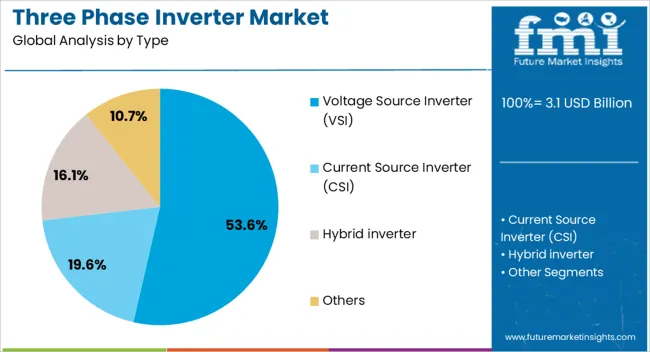
The voltage source inverter segment is projected to hold 53.6% of the total market revenue by 2025, making it the leading type segment. This dominance is driven by its ability to provide stable output voltage, high efficiency, and ease of control, which are essential for renewable energy integration and variable speed motor drives.
The flexibility of VSI technology in handling a wide range of load conditions and its compatibility with modern control algorithms have increased its adoption. Additionally, its compact design and cost effectiveness contribute to widespread use across residential and industrial applications.
The combination of operational efficiency, scalability, and adaptability ensures that the voltage source inverter remains the preferred choice in three phase inverter deployments.
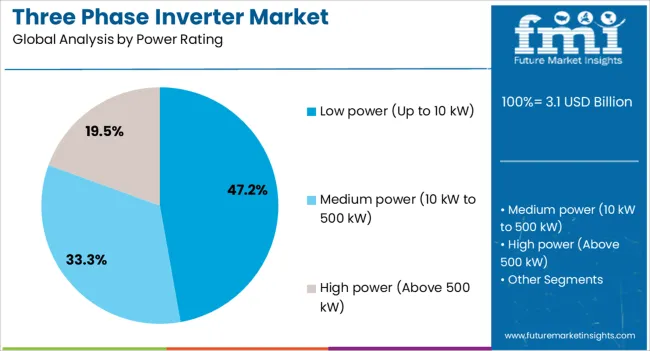
The low power up to 10 kW segment is expected to account for 47.2% of market revenue by 2025, positioning it as the leading power rating category. Growth in this segment is being fueled by the rising adoption of residential solar installations, small scale backup power systems, and decentralized renewable energy solutions.
The lower installation costs and simpler maintenance requirements associated with low power systems make them attractive for households and small businesses. Furthermore, supportive government incentives for residential renewable energy adoption and increasing consumer awareness about energy independence have boosted the demand for this power rating.
The segment’s alignment with the expanding rooftop solar and residential energy storage markets ensures its continued prominence.
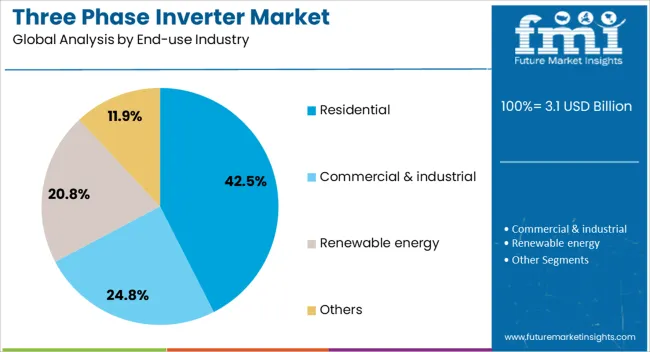
The residential segment is forecast to contribute 42.5% of the total market revenue by 2025, making it the top end use industry. This growth is attributed to increasing household adoption of solar photovoltaic systems, rising electricity costs, and growing consumer preference for energy self sufficiency.
The integration of three phase inverters in residential settings provides improved load balancing, higher efficiency in energy conversion, and compatibility with modern home energy management systems. Additionally, supportive policy frameworks, subsidies, and net metering schemes have further encouraged residential adoption.
The ability to enhance energy reliability and reduce dependence on the grid positions the residential segment as a key driver in the three phase inverter market.
The three-phase inverter market is expected to grow as industrial and commercial applications demand efficient, reliable energy conversion for high-power operations. Demand is reinforced by the rise in renewable energy systems, energy storage solutions, and electric vehicle charging infrastructure. Opportunities are opening in the integration of smart grid capabilities, compact designs, and hybrid energy systems. Trends indicate a move toward modular, scalable inverters with improved efficiency. Challenges include high initial investment costs, integration complexities, and the need for standardization in global markets.
Demand for three-phase inverters has been reinforced by their widespread use in industrial, commercial, and residential applications, where reliable energy conversion is critical. These inverters are essential in converting DC power from renewable sources, such as solar panels, into AC power for grid compatibility. In industrial settings, they are used for large-scale motors, pumps, and HVAC systems. In our opinion, the most significant demand drivers are the increasing adoption of renewable energy systems and electric vehicle charging stations, as these sectors continue to scale.
Opportunities are emerging in the integration of three-phase inverters with smart grid systems and hybrid power setups. As industries and utilities seek more efficient energy management, inverters that can interact with the grid, providing real-time data and responding to demand fluctuations, are becoming highly desirable. Moreover, the growing interest in energy storage solutions is creating demand for inverters capable of handling storage and grid functions simultaneously. From our perspective, the strongest growth will come from solutions that integrate seamlessly with both renewable generation and storage, providing flexibility and cost savings for users.
Trends in the three-phase inverter market are increasingly favoring modular and scalable designs. These systems offer flexibility, allowing for easy expansion in response to growing energy demands, particularly in commercial and industrial applications. Modular inverters are being used in distributed generation systems, making it easier to maintain and upgrade without major system overhauls. Efficiency remains a top priority, with new designs focusing on reducing heat generation and improving power conversion ratios. In our opinion, the market will continue to lean toward designs that offer both scalability and high efficiency to accommodate the evolving energy landscape.
Challenges in the three-phase inverter market arise from high initial investment costs, particularly for large-scale commercial and industrial installations. Integration with existing energy systems, such as grids and storage units, can be complex and costly. The absence of global standardization also creates hurdles for manufacturers seeking to expand in diverse markets, where regional regulations and grid requirements differ. In our view, overcoming these challenges will require clear cost-benefit analyses and solutions that facilitate easy integration, while manufacturers will need to focus on offering products that meet regional compliance standards efficiently.
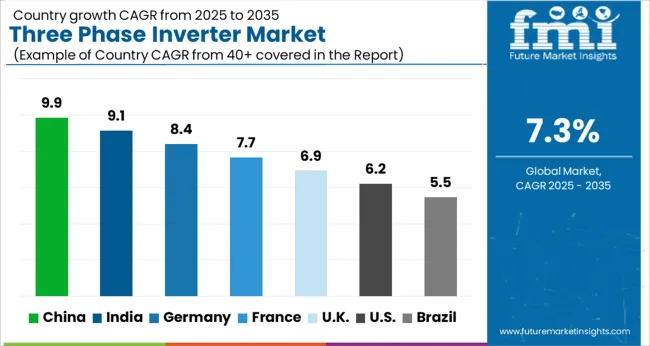
| Country | CAGR |
|---|---|
| China | 9.9% |
| India | 9.1% |
| Germany | 8.4% |
| France | 7.7% |
| UK | 6.9% |
| USA | 6.2% |
| Brazil | 5.5% |
The global three-phase inverter market is projected to grow at 7.3% from 2025 to 2035. China leads at 9.9%, followed by India 9.1% and France 7.7%; the United Kingdom 6.9% and United States 6.2% follow. Demand is driven by the growing adoption of renewable energy systems, including solar, wind, and energy storage solutions, which require efficient power conversion. The increasing need for high-efficiency inverters in residential, commercial, and industrial applications, along with the rise in electric vehicle charging stations and grid modernization, is further propelling market growth. Asia is set to lead in production volume, while Europe and North America focus on regulatory compliance, grid integration, and energy efficiency. In our view, manufacturers emphasizing innovation in energy storage integration, reliability, and cost-effectiveness will capture significant market share. This report includes insights on 40+ countries; the top markets are highlighted for reference.
The three-phase inverter market in China is expected to expand at 9.9%. China’s rapid adoption of renewable energy technologies, particularly solar power, is the primary driver behind the growth of the three-phase inverter market. The country’s aggressive renewable energy targets and government incentives for solar installations have significantly increased demand for high-efficiency inverters. Moreover, the shift towards electric vehicles and the need for efficient charging infrastructure is adding further momentum to the market. Chinese manufacturers are well-positioned to lead due to their cost-effective production capabilities, strong domestic supply chains, and growing export opportunities. China’s commitment to carbon neutrality and energy efficiency will continue to drive the market in the coming years.
The three-phase inverter market in India is projected to grow at 9.1%. India’s increasing focus on renewable energy sources, particularly solar, is driving the demand for high-efficiency inverters in both residential and commercial installations. The Indian government’s initiatives, such as the National Solar Mission, are encouraging the adoption of solar power and related technologies, which directly impacts the demand for inverters. Additionally, the rise of electric vehicles and the growth of charging infrastructure in India further supports the expansion of the three-phase inverter market. As the country shifts towards cleaner energy solutions, the demand for reliable, cost-effective inverters is expected to continue rising.
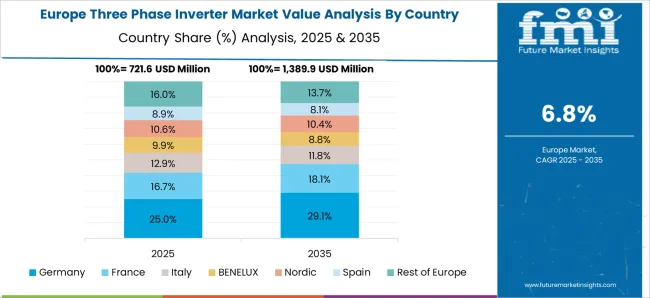
The three-phase inverter market in France is forecast to grow at 7.7%. France’s renewable energy policies, particularly in the solar sector, are pushing the demand for high-performance three-phase inverters. As part of its commitment to the European Union’s renewable energy targets, France is witnessing significant investments in both solar power installations and energy storage systems, which require efficient power conversion. The market is also benefiting from France’s growing demand for electric vehicle infrastructure and the increasing need for reliable grid integration solutions. With strong environmental regulations and a push for energy-efficient solutions, France will continue to be a key market for inverters in Europe.
The three-phase inverter market in the UK is projected to expand at 6.9%. The UK’s commitment to net-zero emissions by 2050 and its ongoing investments in renewable energy sources such as solar and wind are driving the demand for efficient three-phase inverters. The country’s growing adoption of energy storage systems and the rise of electric vehicles are also creating new opportunities for inverters. Additionally, the UK government’s green energy policies and incentives for energy-efficient technologies are further stimulating market growth. As the country looks to meet its renewable energy targets and reduce carbon emissions, the demand for reliable and efficient inverters will continue to rise.
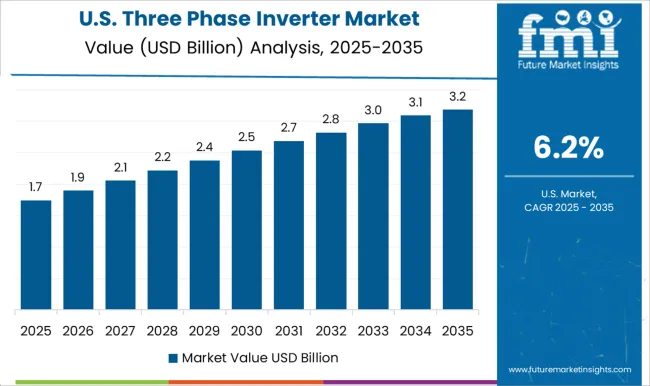
The three-phase inverter market in the United States is projected to grow at 6.2%. With a strong shift towards renewable energy sources such as solar and wind, the demand for high-efficiency three-phase inverters in the USA is rapidly increasing. The growth of solar power installations, particularly in the residential, commercial, and industrial sectors, is driving this demand. Moreover, the expanding electric vehicle market, coupled with the need for charging infrastructure, is creating further opportunities for inverter technologies. The USA government’s renewable energy initiatives and the push for smart grid solutions will continue to drive the growth of the inverter market.
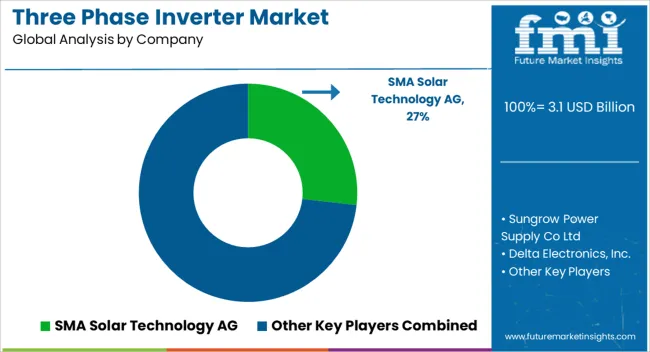
Competition in the three-phase inverter market has been driven by how effectively companies present efficiency, scalability, and grid compatibility in their brochures. SMA Solar Technology AG and Sungrow Power Supply Co Ltd. lead with brochures that emphasize high efficiency rates, extended operational lifespans, and advanced features like maximum power point tracking (MPPT) and remote monitoring. Delta Electronics, Inc. and ABB Ltd. focus on scalable inverter systems, highlighting seamless integration with commercial and residential solar setups, and their ability to maximize energy output while ensuring system stability.
KACO new energy GmbH and FIMER promote their product lines by stressing modular design, ease of installation, and superior cooling techniques, which extend the life of inverters in challenging environmental conditions. Schneider Electric emphasizes their digital solutions for grid integration, showcasing their advanced monitoring systems, and automated fault detection, which optimize energy management and reduce downtime. Strategy has been executed through brochures that provide clear, technical comparisons, helping customers select the right product for their energy needs.
Key specifications like efficiency percentages, power ratings, communication protocols, and environmental resilience are highlighted in tables for quick assessment. Many brochures also emphasize compliance with global standards such as IEC, UL, and IEEE, ensuring that products meet the highest safety and regulatory requirements. Companies that emphasize ease of integration, remote management, and comprehensive warranty options gain a competitive edge. Brochures also showcase real-world applications, case studies, and performance data under various weather conditions, ensuring reliability and trust in product longevity. In this market, clear and detailed brochures serve as essential tools, enabling customers to make informed decisions based on technical specifications, energy savings potential, and system compatibility.
| Items | Values |
|---|---|
| Quantitative Units | USD 3.1 billion |
| Type | Voltage Source Inverter (VSI), Current Source Inverter (CSI), Hybrid inverter, and Others |
| Power Rating | Low power (Up to 10 kW), Medium power (10 kW to 500 kW), and High power (Above 500 kW) |
| End-use Industry | Residential, Commercial & industrial, Renewable energy, and Others |
| Regions Covered | North America, Europe, Asia-Pacific, Latin America, Middle East & Africa |
| Country Covered | United States, Canada, Germany, France, United Kingdom, China, Japan, India, Brazil, South Africa |
| Key Companies Profiled | SMA Solar Technology AG, Sungrow Power Supply Co Ltd, Delta Electronics, Inc., KACO new energy GmbH, ABB Ltd, Schneider Electric, and FIMER |
| Additional Attributes | Dollar sales of inverters span types, power ratings, and applications, fueled by renewables, EVs, automation; smart grids, storage, wide-bandgap semiconductors enhance efficiency, stability; Asia-Pacific dominates, with North America, Europe following. |
The global three phase inverter market is estimated to be valued at USD 3.1 billion in 2025.
The market size for the three phase inverter market is projected to reach USD 6.2 billion by 2035.
The three phase inverter market is expected to grow at a 7.3% CAGR between 2025 and 2035.
The key product types in three phase inverter market are voltage source inverter (vsi), current source inverter (csi), hybrid inverter and others.
In terms of power rating, low power (up to 10 kw) segment to command 47.2% share in the three phase inverter market in 2025.






Full Research Suite comprises of:
Market outlook & trends analysis
Interviews & case studies
Strategic recommendations
Vendor profiles & capabilities analysis
5-year forecasts
8 regions and 60+ country-level data splits
Market segment data splits
12 months of continuous data updates
DELIVERED AS:
PDF EXCEL ONLINE
Three Phase Micro Inverter Market Size and Share Forecast Outlook 2025 to 2035
Three Phase String Inverter Market Size and Share Forecast Outlook 2025 to 2035
On-grid Three Phase PV Inverter Market Size and Share Forecast Outlook 2025 to 2035
Standalone Three Phase PV Inverter Market Size and Share Forecast Outlook 2025 to 2035
Commercial Three Phase Micro Inverter Market Size and Share Forecast Outlook 2025 to 2035
Three Wheeled Motorcycle Market Size and Share Forecast Outlook 2025 to 2035
Three-Wheel E-Scooter Market Growth - Trends & Forecast 2024 to 2034
Three Piece Cans Market
Three Phase Commercial Voltage Regulator Market Size and Share Forecast Outlook 2025 to 2035
Three Phase Residential Voltage Regulator Market Size and Share Forecast Outlook 2025 to 2035
Three Phase Recloser Market Size and Share Forecast Outlook 2025 to 2035
Three Phase Green Power Transformer Market Size and Share Forecast Outlook 2025 to 2035
Three Phase Residential Power Conditioner Market Size and Share Forecast Outlook 2025 to 2035
Three Phase Shunt Reactor Market Size and Share Forecast Outlook 2025 to 2035
Three Phase Power Device Analyzer Market Size and Share Forecast Outlook 2025 to 2035
Electric Three Wheeler Market - Trends & Forecast 2025 to 2035
Automotive Three Way Catalytic Converter Market Size and Share Forecast Outlook 2025 to 2035
Air Cooled Three Phase Home Standby Gensets Market Size and Share Forecast Outlook 2025 to 2035
Phase Shifting Transformer Market Size and Share Forecast Outlook 2025 to 2035
Dual-Phase Cleanser Market Size and Share Forecast Outlook 2025 to 2035

Thank you!
You will receive an email from our Business Development Manager. Please be sure to check your SPAM/JUNK folder too.
Chat With
MaRIA